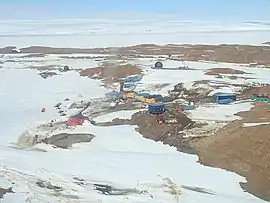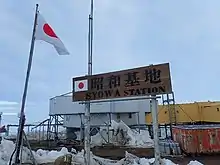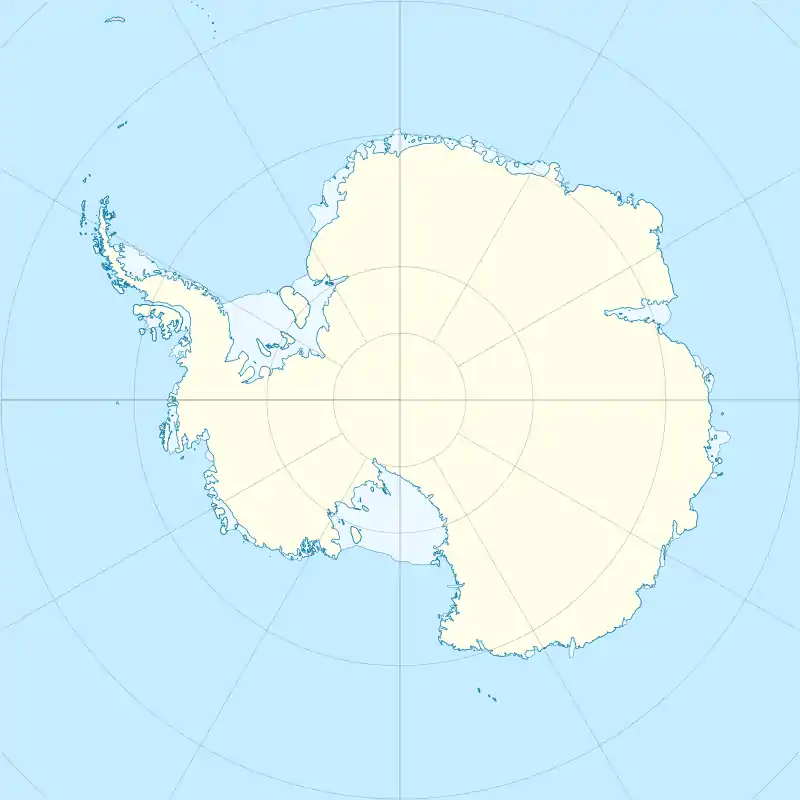Showa Station (Antarctica)
Showa Station (Japanese: 昭和基地, Hepburn: Shōwa Kichi), sometimes alternately spelled Syowa Station,[2] is a Japanese permanent research station on East Ongul Island in Queen Maud Land, Antarctica. Built in 1957, Showa Station is named for the era in the Japanese calendar during which it was established, the Shōwa period.
Showa
昭和基地 | |
|---|---|
| Shōwa Kichi | |
 Aerial photograph of Showa Station, December 2018. | |
 Showa Location of Showa Station in Antarctica | |
| Coordinates: 69°00′15″S 39°34′55″E | |
| Country | |
| Location in Antarctica | East Ongul Island Queen Maud Land Antarctica |
| Administered by | Japanese Antarctic Program |
| Established | 1957 |
| Elevation | 29 m (95 ft) |
| Population (2017)[1] | |
| • Summer | 170 |
| • Winter | 40 |
| Time zone | UTC+3 (SYOT) |
| Type | All-year round |
| Period | Annual |
| Status | Operational |
| Activities | PANSY incoherent scatter radar |
| Facilities | 60 separate buildings |
| Website | National Institute of Polar Research |
Overview

Showa Station serves as a research outpost for astronomy, meteorology, biology and earth sciences. It comprises over 60 separate buildings, large and small, including a 3-storey administration building, living quarters, power plant, sewage treatment facility, environmental science building, observatory, data processing facility, satellite building, ionospheric station, incinerator, earth science building, and radiosonde station. Also present are fuel tanks, water storage, solar panels, a heliport, water retention dam, and radio transmitter.
PANSY Incoherent Scatter Radar
Showa station is home to the Program of the Antarctic Syowa Mesosphere–Stratosphere–Troposphere/Incoherent Scatter (PANSY) incoherent scatter radar, which took its first measurements in 2017.[3]
Legacy
1957 Expedition
The station was founded by the inaugural Japanese Antarctic Research Expedition in 1957. This expedition was airlifted out after a storm (by a nearby American ship that had a helicopter). However there was no space for the dogs to get on. The storm made deploying the second team impossible in February 1958. In January 1959, the third team returned to the station and found that, of the 15 sled dogs that had been left by the first team at the base, two, Taro and Jiro, had survived.
Historic monument
A cairn and plaque at the station commemorate Shin Fukushima, a member of the 4th Japanese Antarctic Research Expedition, who died in October 1960 while carrying out his duties. The cairn, which contains some of his ashes, was erected on 11 January 1961 by his colleagues. It has been designated a Historic Site or Monument (HSM 2) following a proposal by Japan to the Antarctic Treaty Consultative Meeting.[4]
In popular culture
- Showa Station is the Antarctic destination of the protagonists of A Place Further than the Universe, a 2018 Japanese anime series.
- The monster Ghidorah is located on the base - called "Outpost 32" - in the 2019 film Godzilla: King of the Monsters
- Showa Station is depicted in the 1983 film Antarctica.
Climate
The climate is classified as an Ice cap climate (Köppen: EF), since there are no months where the average temperature exceeds 0.0 °C (32.0 °F).
| Climate data for Showa Station (1991−2020 normals, extremes 1957−present) | |||||||||||||
|---|---|---|---|---|---|---|---|---|---|---|---|---|---|
| Month | Jan | Feb | Mar | Apr | May | Jun | Jul | Aug | Sep | Oct | Nov | Dec | Year |
| Record high °C (°F) | 10.0 (50.0) |
8.0 (46.4) |
3.6 (38.5) |
0.5 (32.9) |
2.8 (37.0) |
−0.7 (30.7) |
−2.5 (27.5) |
−2.8 (27.0) |
−1.1 (30.0) |
2.6 (36.7) |
7.3 (45.1) |
9.4 (48.9) |
10.0 (50.0) |
| Average high °C (°F) | 1.8 (35.2) |
−0.6 (30.9) |
−4.5 (23.9) |
−7.8 (18.0) |
−10.6 (12.9) |
−11.9 (10.6) |
−14.3 (6.3) |
−15.2 (4.6) |
−15.0 (5.0) |
−10.5 (13.1) |
−3.5 (25.7) |
1.1 (34.0) |
−7.6 (18.3) |
| Daily mean °C (°F) | −0.8 (30.6) |
−2.9 (26.8) |
−6.8 (19.8) |
−10.4 (13.3) |
−13.5 (7.7) |
−15.2 (4.6) |
−17.6 (0.3) |
−18.8 (−1.8) |
−18.3 (−0.9) |
−13.3 (8.1) |
−6.3 (20.7) |
−1.5 (29.3) |
−10.5 (13.1) |
| Average low °C (°F) | −3.7 (25.3) |
−5.6 (21.9) |
−9.7 (14.5) |
−13.4 (7.9) |
−16.9 (1.6) |
−18.7 (−1.7) |
−21.4 (−6.5) |
−22.8 (−9.0) |
−22.3 (−8.1) |
−17.1 (1.2) |
−9.9 (14.2) |
−4.6 (23.7) |
−13.8 (7.2) |
| Record low °C (°F) | −12.6 (9.3) |
−18.2 (−0.8) |
−25.2 (−13.4) |
−35.9 (−32.6) |
−40.5 (−40.9) |
−38.3 (−36.9) |
−42.7 (−44.9) |
−42.2 (−44.0) |
−45.3 (−49.5) |
−34.7 (−30.5) |
−25.0 (−13.0) |
−12.9 (8.8) |
−45.3 (−49.5) |
| Average relative humidity (%) | 70 | 70 | 71 | 73 | 69 | 68 | 69 | 68 | 67 | 70 | 68 | 70 | 69 |
| Mean monthly sunshine hours | 346.7 | 186.9 | 118.4 | 59.8 | 22.4 | 0.0 | 6.2 | 65.0 | 144.4 | 194.1 | 320.5 | 414.2 | 1,894.4 |
| Source: Japan Meteorological Agency[5] | |||||||||||||
See also
Showa | |||||||||||
|---|---|---|---|---|---|---|---|---|---|---|---|
| Summary | |||||||||||
| Airport type | Private | ||||||||||
| Serves | Syowa | ||||||||||
| Location | East Ongul Island | ||||||||||
| Time zone | (+3) | ||||||||||
| Elevation AMSL | 95 ft / 29 m | ||||||||||
| Coordinates | 69°00′22″S 39°35′24″E | ||||||||||
| Map | |||||||||||
 Showa Location of airfield in Antarctica | |||||||||||
| Runways | |||||||||||
| |||||||||||
References
- Antarctic Station Catalogue (PDF) (catalogue). Council of Managers of National Antarctic Programs. August 2017. p. 89. ISBN 978-0-473-40409-3. Archived (PDF) from the original on October 22, 2022. Retrieved January 16, 2023.
- "Showa Station (Syowa Station), East Ongul Island, Lützow-Holm Bay, Queen Maud Land (Dronning Maud Land), Eastern Antarctica, Antarctica". mindat.org. Retrieved June 29, 2007.
- Hashimoto, Taishi (September 2019). "PANSY Radar at Syowa Station, Antarctic". Journal of Atmospheric and Oceanic Technology. American Meteorological Society. 36 (9): 1881–1888. doi:10.1175/JTECH-D-18-0175.1. S2CID 199683788. Retrieved December 22, 2020.
- "List of Historic Sites and Monuments approved by the ATCM (2012)" (PDF). Antarctic Treaty Secretariat. 2012. Retrieved October 24, 2013.
- 気象庁 / 平年値(年・月ごとの値). Japan Meteorological Agency. Retrieved May 19, 2021.
- "Showa Skiway". Airport Nav Finder. Retrieved October 17, 2018.
.svg.png.webp)